Analysis of IoT and RFID: Technologies, Applications, and Impacts
VerifiedAdded on 2020/06/05
|7
|1505
|91
Report
AI Summary
This report examines the Internet of Things (IoT) and Radio-Frequency Identification (RFID) technologies. It delves into the concept of IoT, discussing its applications in smart devices, data collection, and its impact on various aspects of life, including healthcare and security. The report also explores the technical and social perspectives of IoT, highlighting its potential benefits and challenges. Furthermore, the report analyzes RFID technology, outlining its applications in product identification, particularly within the context of streamlining organizational processes. It provides a comparative analysis with barcodes, discussing the strengths and weaknesses of RFID, including cost considerations, scanning capabilities, and potential issues such as tag collision. The report also includes a cost analysis for RFID implementation and concludes with a discussion on the importance of Electronic Product Code (EPC) for effective product identification. References from academic journals and online resources are also included.
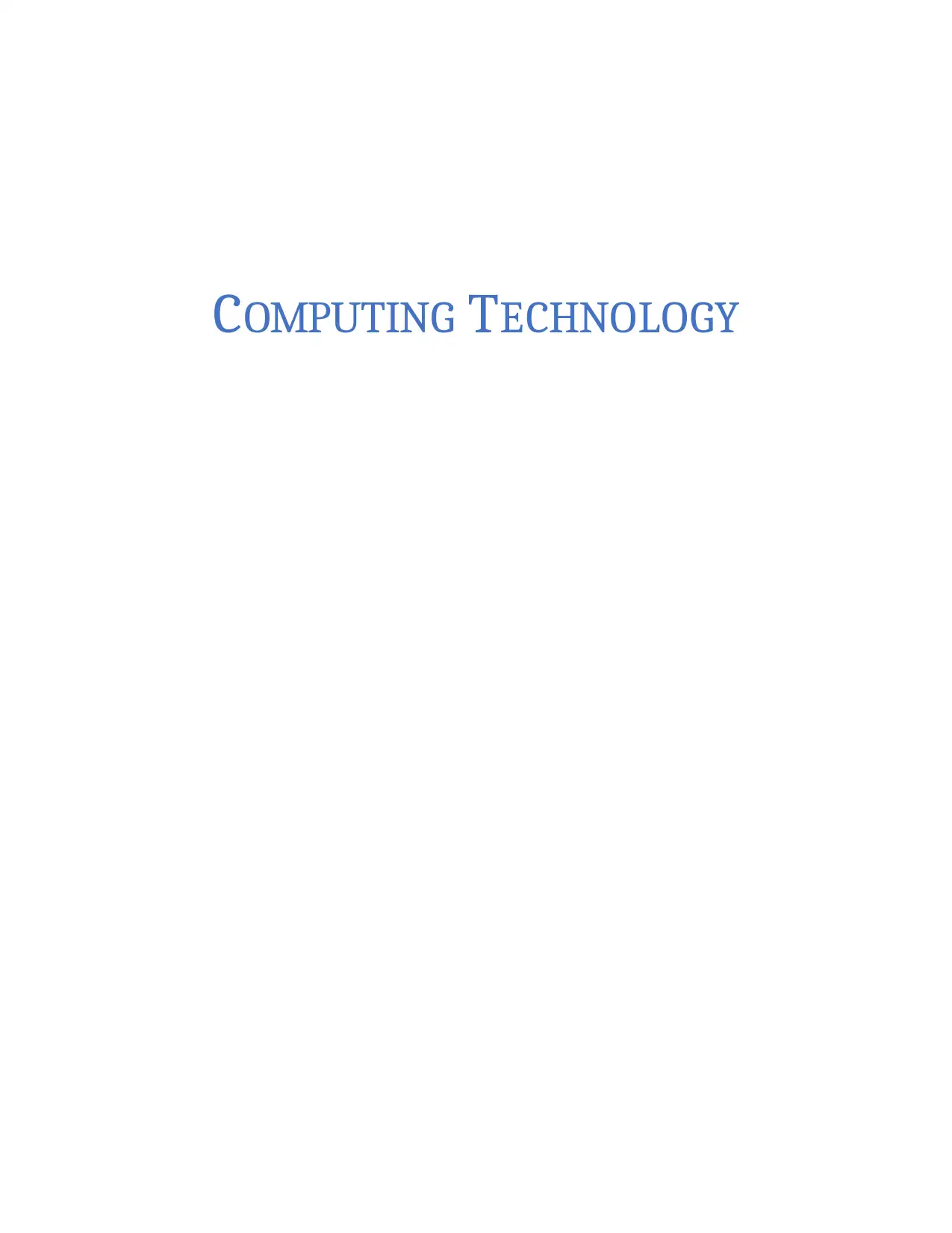
COMPUTING TECHNOLOGY
Paraphrase This Document
Need a fresh take? Get an instant paraphrase of this document with our AI Paraphraser
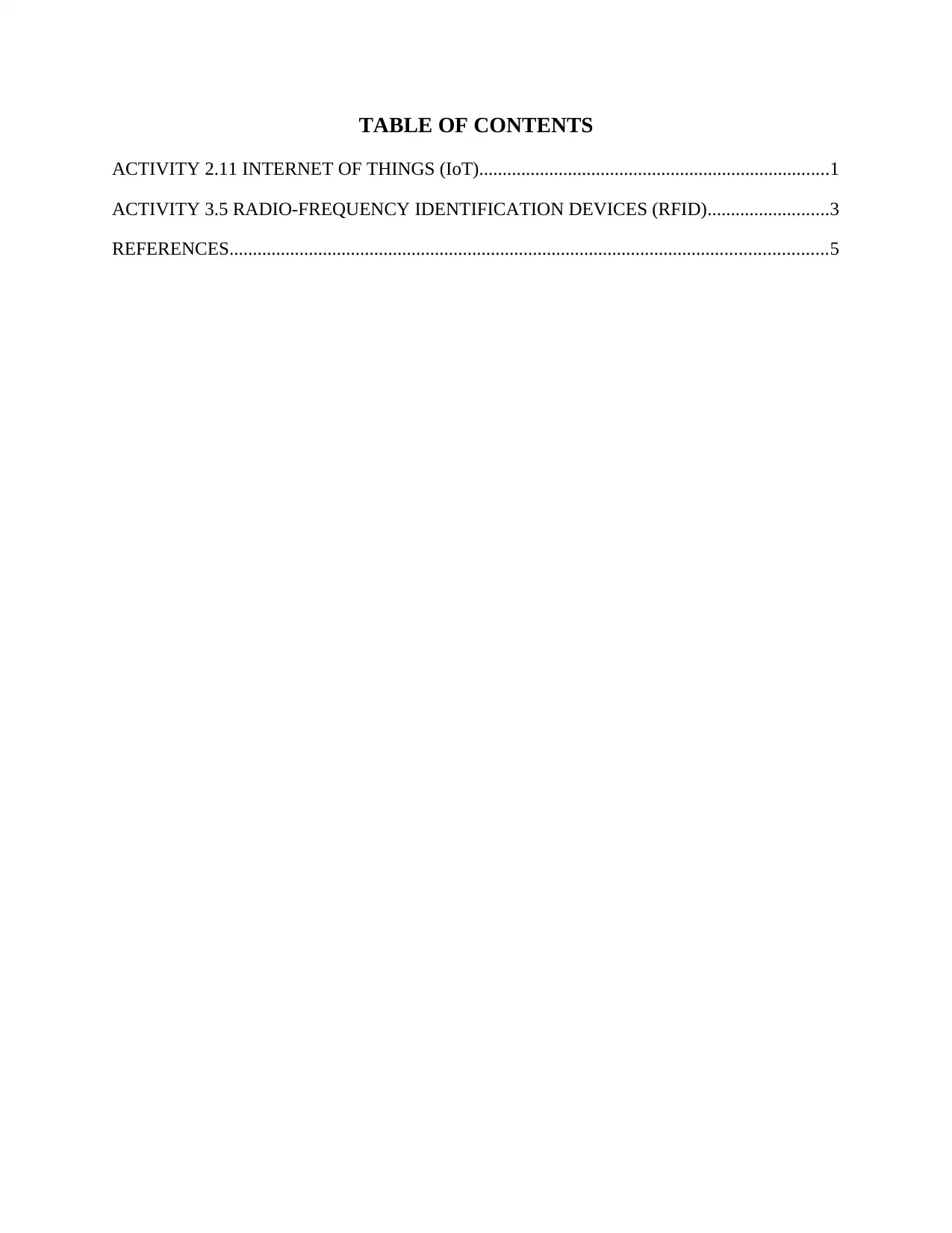
TABLE OF CONTENTS
ACTIVITY 2.11 INTERNET OF THINGS (IoT)...........................................................................1
ACTIVITY 3.5 RADIO-FREQUENCY IDENTIFICATION DEVICES (RFID)..........................3
REFERENCES................................................................................................................................5
ACTIVITY 2.11 INTERNET OF THINGS (IoT)...........................................................................1
ACTIVITY 3.5 RADIO-FREQUENCY IDENTIFICATION DEVICES (RFID)..........................3
REFERENCES................................................................................................................................5
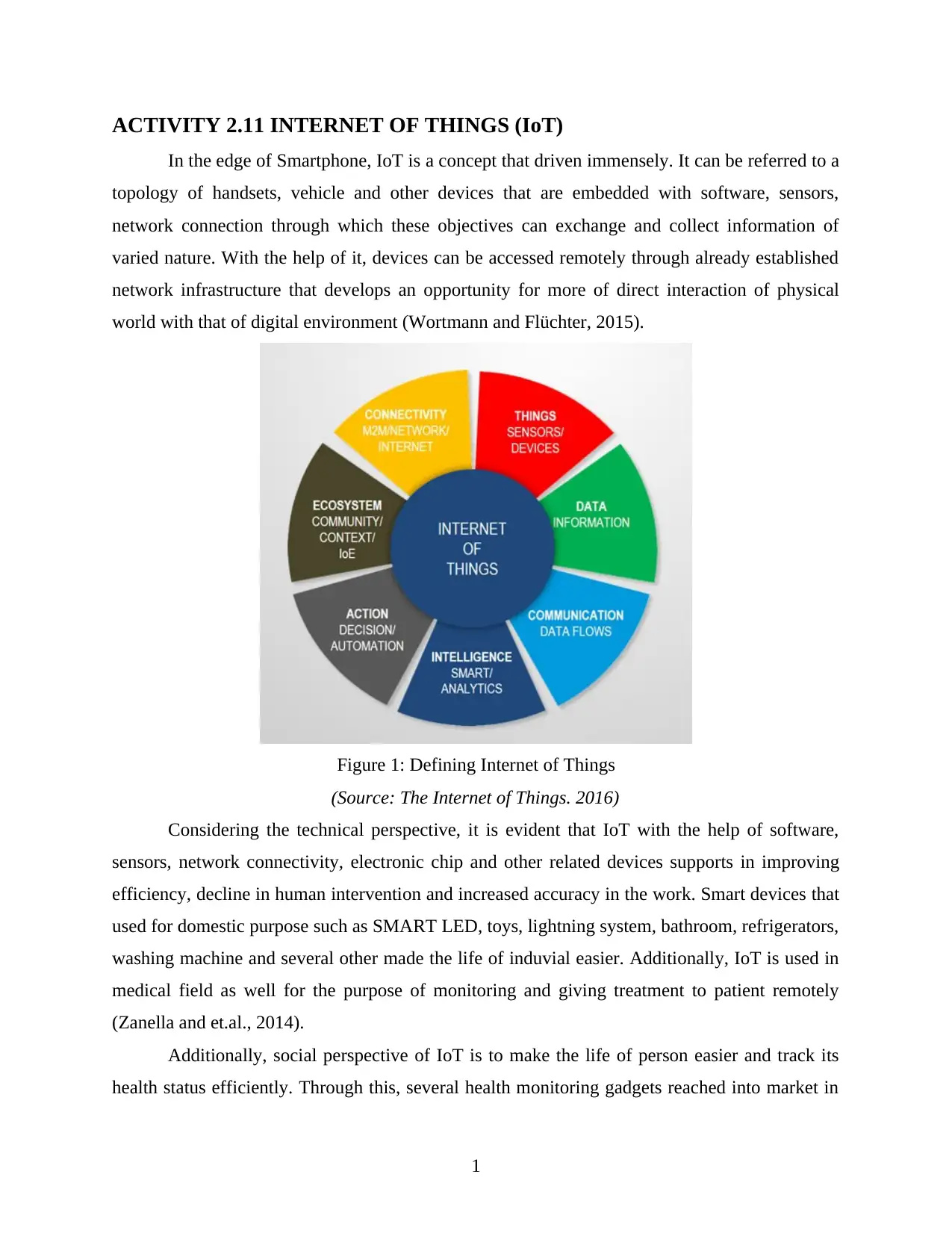
ACTIVITY 2.11 INTERNET OF THINGS (IoT)
In the edge of Smartphone, IoT is a concept that driven immensely. It can be referred to a
topology of handsets, vehicle and other devices that are embedded with software, sensors,
network connection through which these objectives can exchange and collect information of
varied nature. With the help of it, devices can be accessed remotely through already established
network infrastructure that develops an opportunity for more of direct interaction of physical
world with that of digital environment (Wortmann and Flüchter, 2015).
Figure 1: Defining Internet of Things
(Source: The Internet of Things. 2016)
Considering the technical perspective, it is evident that IoT with the help of software,
sensors, network connectivity, electronic chip and other related devices supports in improving
efficiency, decline in human intervention and increased accuracy in the work. Smart devices that
used for domestic purpose such as SMART LED, toys, lightning system, bathroom, refrigerators,
washing machine and several other made the life of induvial easier. Additionally, IoT is used in
medical field as well for the purpose of monitoring and giving treatment to patient remotely
(Zanella and et.al., 2014).
Additionally, social perspective of IoT is to make the life of person easier and track its
health status efficiently. Through this, several health monitoring gadgets reached into market in
1
In the edge of Smartphone, IoT is a concept that driven immensely. It can be referred to a
topology of handsets, vehicle and other devices that are embedded with software, sensors,
network connection through which these objectives can exchange and collect information of
varied nature. With the help of it, devices can be accessed remotely through already established
network infrastructure that develops an opportunity for more of direct interaction of physical
world with that of digital environment (Wortmann and Flüchter, 2015).
Figure 1: Defining Internet of Things
(Source: The Internet of Things. 2016)
Considering the technical perspective, it is evident that IoT with the help of software,
sensors, network connectivity, electronic chip and other related devices supports in improving
efficiency, decline in human intervention and increased accuracy in the work. Smart devices that
used for domestic purpose such as SMART LED, toys, lightning system, bathroom, refrigerators,
washing machine and several other made the life of induvial easier. Additionally, IoT is used in
medical field as well for the purpose of monitoring and giving treatment to patient remotely
(Zanella and et.al., 2014).
Additionally, social perspective of IoT is to make the life of person easier and track its
health status efficiently. Through this, several health monitoring gadgets reached into market in
1
⊘ This is a preview!⊘
Do you want full access?
Subscribe today to unlock all pages.

Trusted by 1+ million students worldwide

the form of Smart Band, smart shoes, smart watch, smartphones and several other. From this, life
expectancy of individual increased significantly and also assisted in diagnosing the diseases in
lesser time frame (Perera and et.al., 2014).
Considering the rise of IoT, it can be state that I want to live in a world where devices
supports me in my daily work. With the help of several devices, a complex interchange of data is
developed which will certainly help me in gaining varied set of information. From this, my
health aspect will be on tracking mode always and also, I can identify any loopholes in the same.
Basically, IoT act as a monitoring and controlling tool from me which will aid me taking quicker
decisions. Devices like Smart band and smartphones are capable of recording several data that
proves beneficial for individual. Security is another reason that can be achieved with the help of
IoT. Smart vaults, plastic money, biometric authentication and other related technology aids in
making complex process easier.
Figure 2: Data Collection Point
(Source: The Internet of Things. 2016)
However, interchange of data can be harmful due to act of hacking and fraudulent
activity. Therefore, it can be evident that I need to live in a world where devices can only
interchange data related to daily work and not include data that can harm me or my family either
physically, financially or in any other mode. Hence, it can be state that IoT possess high
opportunities in reducing the human intervention.
2
expectancy of individual increased significantly and also assisted in diagnosing the diseases in
lesser time frame (Perera and et.al., 2014).
Considering the rise of IoT, it can be state that I want to live in a world where devices
supports me in my daily work. With the help of several devices, a complex interchange of data is
developed which will certainly help me in gaining varied set of information. From this, my
health aspect will be on tracking mode always and also, I can identify any loopholes in the same.
Basically, IoT act as a monitoring and controlling tool from me which will aid me taking quicker
decisions. Devices like Smart band and smartphones are capable of recording several data that
proves beneficial for individual. Security is another reason that can be achieved with the help of
IoT. Smart vaults, plastic money, biometric authentication and other related technology aids in
making complex process easier.
Figure 2: Data Collection Point
(Source: The Internet of Things. 2016)
However, interchange of data can be harmful due to act of hacking and fraudulent
activity. Therefore, it can be evident that I need to live in a world where devices can only
interchange data related to daily work and not include data that can harm me or my family either
physically, financially or in any other mode. Hence, it can be state that IoT possess high
opportunities in reducing the human intervention.
2
Paraphrase This Document
Need a fresh take? Get an instant paraphrase of this document with our AI Paraphraser

ACTIVITY 3.5 RADIO-FREQUENCY IDENTIFICATION DEVICES
(RFID)
RFID can be referred as a technology which uses the radio waves for reading and
capturing the information that stored in particular tag. With the rise in time, scope of RFID
emerged certainly and supports in managing complex process. Considering the case of applying
RFID for product identification, it will be beneficial for organisation in making process more
streamline. Unlike bar codes, RFID can transmit data even tag is not in a single line which
increases the efficiency of this technology in production industry. In addition to it, there are
several strengths of using RFID for product identification, same have been enumerated below:
Feasible approach: Use of RFID is a feasible approach as it includes use of radio waves
by the reader. With this mechanism, it becomes easier for the company to apply RFID tag
on product of every nature (Amendola and et.al., 2014). Bar codes can be destroyed or
damage but same is not the scenario in case of RFID.
Scanning Range: RFID reader possess a wide scanning range as compared to its
substitute. Also, it doesn’t possess any line of sight limitations. Bar codes, on the
contrary, need to be scan by keeping it close to reader which is more time consuming and
effort including work.
RFID Capabilities: This technology can scan multiple product at the same time which
leads to saving of considerable amount of time. With the help of it, data of inventory can
be developed in lesser time frame (Fan and et.al., 2015). Further, it is more convenient
and quick which makes operation faster. This can be installed for product identification
within the organisation and can results into faster scanning.
Contrary to this, there are certain weaknesses of RFID:
o Costly Affair: As compared to bar codes, it is evident that RFID is more expensive
within the context of setting up. However, it results into several cost benefits i.e. decline
in labour cost and time-consuming process.
o Scanning Issue: Despite of wide scanning range, it can still have issue from metal and
water. Also, tag collision may arise in case if reader gets the signal from multiple tags at
same point of time (Cui, Wang and Deng, 2014).
3
(RFID)
RFID can be referred as a technology which uses the radio waves for reading and
capturing the information that stored in particular tag. With the rise in time, scope of RFID
emerged certainly and supports in managing complex process. Considering the case of applying
RFID for product identification, it will be beneficial for organisation in making process more
streamline. Unlike bar codes, RFID can transmit data even tag is not in a single line which
increases the efficiency of this technology in production industry. In addition to it, there are
several strengths of using RFID for product identification, same have been enumerated below:
Feasible approach: Use of RFID is a feasible approach as it includes use of radio waves
by the reader. With this mechanism, it becomes easier for the company to apply RFID tag
on product of every nature (Amendola and et.al., 2014). Bar codes can be destroyed or
damage but same is not the scenario in case of RFID.
Scanning Range: RFID reader possess a wide scanning range as compared to its
substitute. Also, it doesn’t possess any line of sight limitations. Bar codes, on the
contrary, need to be scan by keeping it close to reader which is more time consuming and
effort including work.
RFID Capabilities: This technology can scan multiple product at the same time which
leads to saving of considerable amount of time. With the help of it, data of inventory can
be developed in lesser time frame (Fan and et.al., 2015). Further, it is more convenient
and quick which makes operation faster. This can be installed for product identification
within the organisation and can results into faster scanning.
Contrary to this, there are certain weaknesses of RFID:
o Costly Affair: As compared to bar codes, it is evident that RFID is more expensive
within the context of setting up. However, it results into several cost benefits i.e. decline
in labour cost and time-consuming process.
o Scanning Issue: Despite of wide scanning range, it can still have issue from metal and
water. Also, tag collision may arise in case if reader gets the signal from multiple tags at
same point of time (Cui, Wang and Deng, 2014).
3
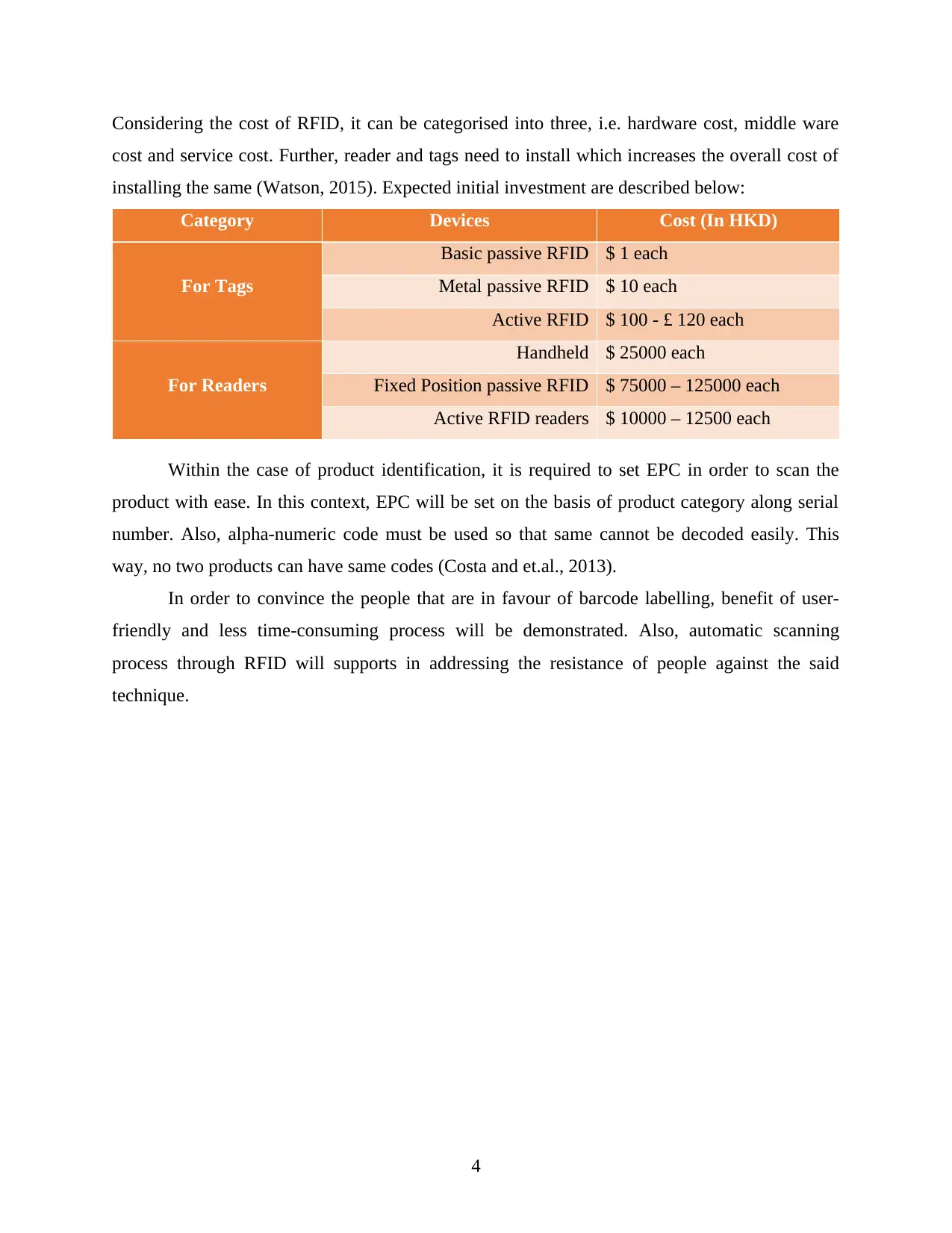
Considering the cost of RFID, it can be categorised into three, i.e. hardware cost, middle ware
cost and service cost. Further, reader and tags need to install which increases the overall cost of
installing the same (Watson, 2015). Expected initial investment are described below:
Category Devices Cost (In HKD)
For Tags
Basic passive RFID $ 1 each
Metal passive RFID $ 10 each
Active RFID $ 100 - £ 120 each
For Readers
Handheld $ 25000 each
Fixed Position passive RFID $ 75000 – 125000 each
Active RFID readers $ 10000 – 12500 each
Within the case of product identification, it is required to set EPC in order to scan the
product with ease. In this context, EPC will be set on the basis of product category along serial
number. Also, alpha-numeric code must be used so that same cannot be decoded easily. This
way, no two products can have same codes (Costa and et.al., 2013).
In order to convince the people that are in favour of barcode labelling, benefit of user-
friendly and less time-consuming process will be demonstrated. Also, automatic scanning
process through RFID will supports in addressing the resistance of people against the said
technique.
4
cost and service cost. Further, reader and tags need to install which increases the overall cost of
installing the same (Watson, 2015). Expected initial investment are described below:
Category Devices Cost (In HKD)
For Tags
Basic passive RFID $ 1 each
Metal passive RFID $ 10 each
Active RFID $ 100 - £ 120 each
For Readers
Handheld $ 25000 each
Fixed Position passive RFID $ 75000 – 125000 each
Active RFID readers $ 10000 – 12500 each
Within the case of product identification, it is required to set EPC in order to scan the
product with ease. In this context, EPC will be set on the basis of product category along serial
number. Also, alpha-numeric code must be used so that same cannot be decoded easily. This
way, no two products can have same codes (Costa and et.al., 2013).
In order to convince the people that are in favour of barcode labelling, benefit of user-
friendly and less time-consuming process will be demonstrated. Also, automatic scanning
process through RFID will supports in addressing the resistance of people against the said
technique.
4
⊘ This is a preview!⊘
Do you want full access?
Subscribe today to unlock all pages.

Trusted by 1+ million students worldwide
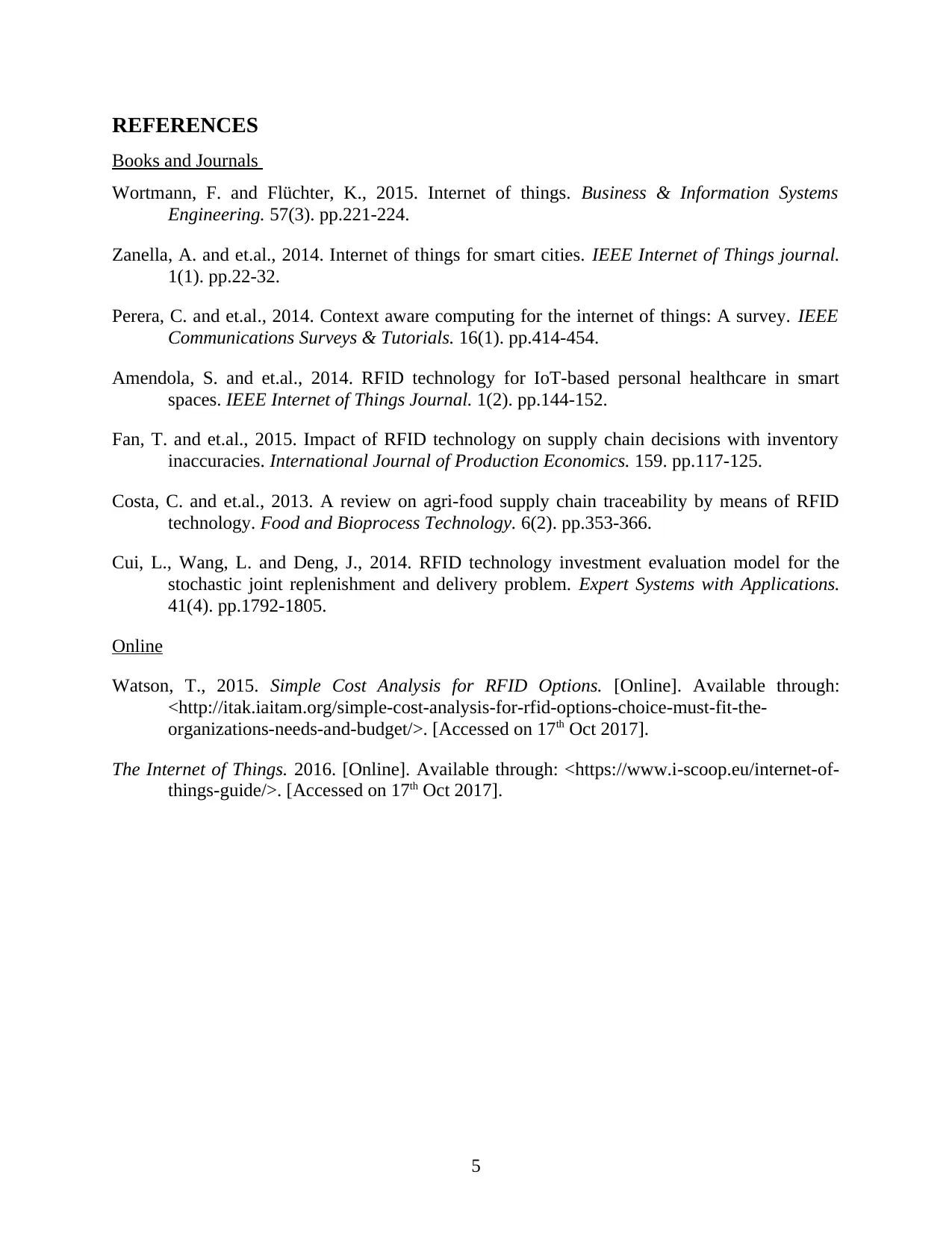
REFERENCES
Books and Journals
Wortmann, F. and Flüchter, K., 2015. Internet of things. Business & Information Systems
Engineering. 57(3). pp.221-224.
Zanella, A. and et.al., 2014. Internet of things for smart cities. IEEE Internet of Things journal.
1(1). pp.22-32.
Perera, C. and et.al., 2014. Context aware computing for the internet of things: A survey. IEEE
Communications Surveys & Tutorials. 16(1). pp.414-454.
Amendola, S. and et.al., 2014. RFID technology for IoT-based personal healthcare in smart
spaces. IEEE Internet of Things Journal. 1(2). pp.144-152.
Fan, T. and et.al., 2015. Impact of RFID technology on supply chain decisions with inventory
inaccuracies. International Journal of Production Economics. 159. pp.117-125.
Costa, C. and et.al., 2013. A review on agri-food supply chain traceability by means of RFID
technology. Food and Bioprocess Technology. 6(2). pp.353-366.
Cui, L., Wang, L. and Deng, J., 2014. RFID technology investment evaluation model for the
stochastic joint replenishment and delivery problem. Expert Systems with Applications.
41(4). pp.1792-1805.
Online
Watson, T., 2015. Simple Cost Analysis for RFID Options. [Online]. Available through:
<http://itak.iaitam.org/simple-cost-analysis-for-rfid-options-choice-must-fit-the-
organizations-needs-and-budget/>. [Accessed on 17th Oct 2017].
The Internet of Things. 2016. [Online]. Available through: <https://www.i-scoop.eu/internet-of-
things-guide/>. [Accessed on 17th Oct 2017].
5
Books and Journals
Wortmann, F. and Flüchter, K., 2015. Internet of things. Business & Information Systems
Engineering. 57(3). pp.221-224.
Zanella, A. and et.al., 2014. Internet of things for smart cities. IEEE Internet of Things journal.
1(1). pp.22-32.
Perera, C. and et.al., 2014. Context aware computing for the internet of things: A survey. IEEE
Communications Surveys & Tutorials. 16(1). pp.414-454.
Amendola, S. and et.al., 2014. RFID technology for IoT-based personal healthcare in smart
spaces. IEEE Internet of Things Journal. 1(2). pp.144-152.
Fan, T. and et.al., 2015. Impact of RFID technology on supply chain decisions with inventory
inaccuracies. International Journal of Production Economics. 159. pp.117-125.
Costa, C. and et.al., 2013. A review on agri-food supply chain traceability by means of RFID
technology. Food and Bioprocess Technology. 6(2). pp.353-366.
Cui, L., Wang, L. and Deng, J., 2014. RFID technology investment evaluation model for the
stochastic joint replenishment and delivery problem. Expert Systems with Applications.
41(4). pp.1792-1805.
Online
Watson, T., 2015. Simple Cost Analysis for RFID Options. [Online]. Available through:
<http://itak.iaitam.org/simple-cost-analysis-for-rfid-options-choice-must-fit-the-
organizations-needs-and-budget/>. [Accessed on 17th Oct 2017].
The Internet of Things. 2016. [Online]. Available through: <https://www.i-scoop.eu/internet-of-
things-guide/>. [Accessed on 17th Oct 2017].
5
1 out of 7
Related Documents
Your All-in-One AI-Powered Toolkit for Academic Success.
+13062052269
info@desklib.com
Available 24*7 on WhatsApp / Email
![[object Object]](/_next/static/media/star-bottom.7253800d.svg)
Unlock your academic potential
Copyright © 2020–2025 A2Z Services. All Rights Reserved. Developed and managed by ZUCOL.



